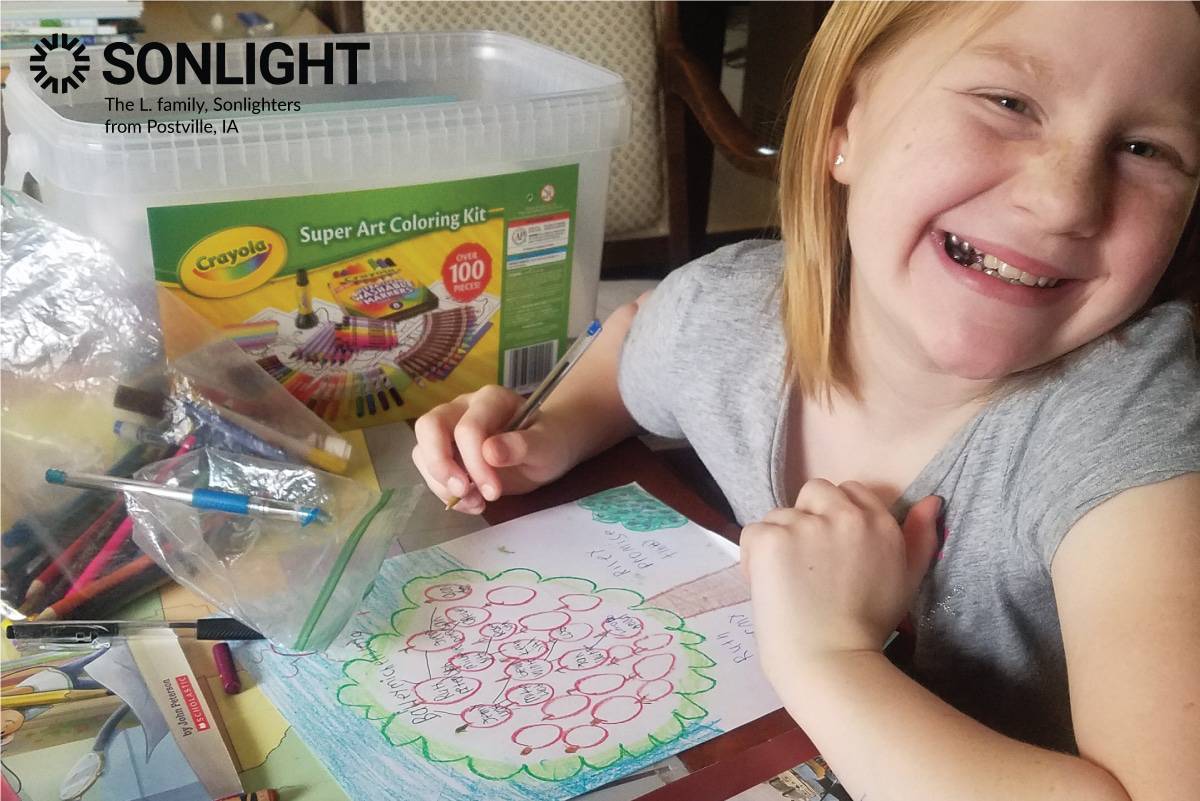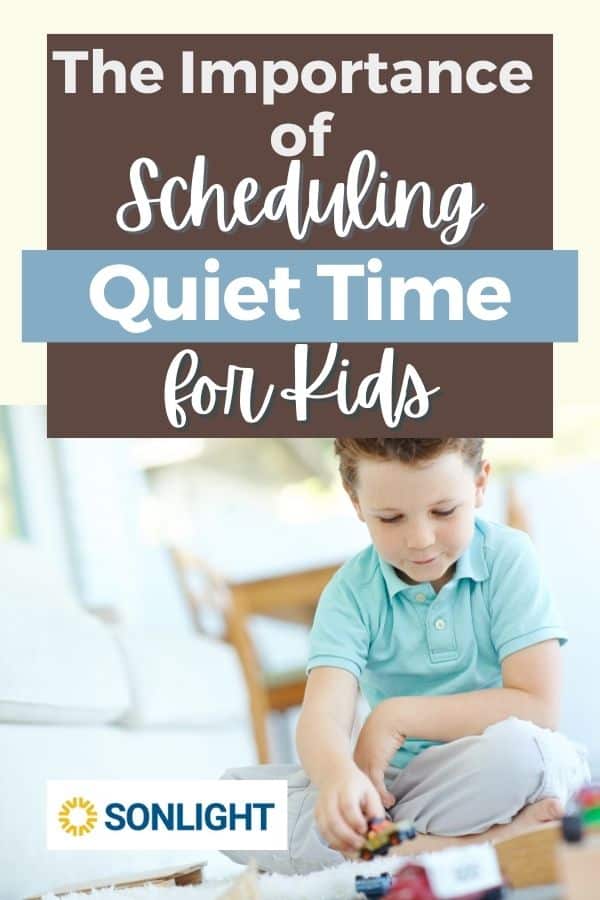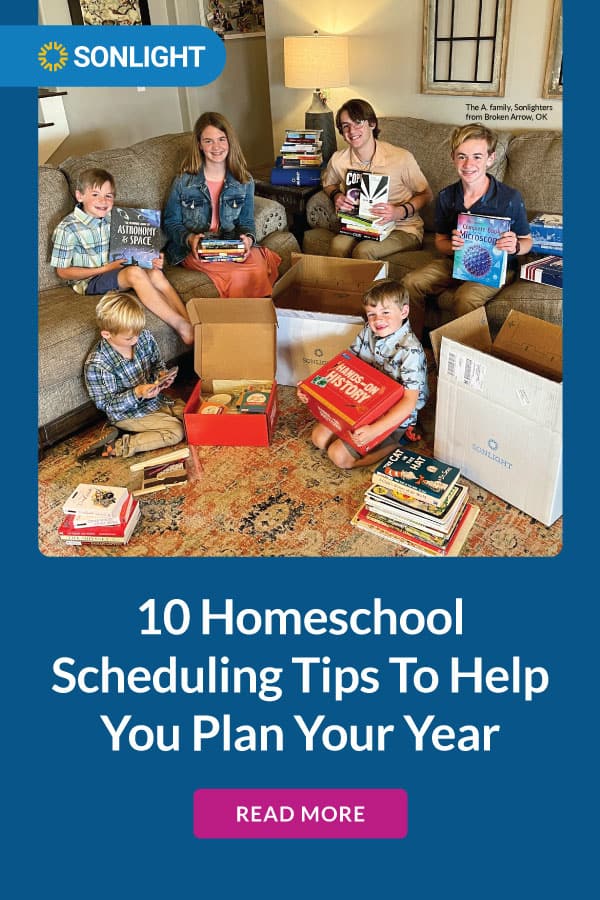How to Find a Homeschool Routine that Works for You
Published:
March 26, 2021

Contributor:
Sonlight
Disclosure: This post may contain affiliate links, meaning if you decide to make a purchase via my links, I may earn a commission at no additional cost to you. See my disclosure for more info.
Watch the video above or scan the transcript below to learn how Ana Willis of They Call Me Blessed creates homeschool schedules and routines that make life run smoothly.
Stephanie (00:00): Ana is a blogger at TheyCallMeBlessed.org. She also has a homeschool group, Blessed Homeschool Moms on Facebook; you can find her there. She is like the guru of schedules and organization, and she is going to talk to us today a little bit about homeschool schedules that work. Welcome, Ana, thank you so much for joining me.
Ana (00:25): Thank you, Stephanie. So good to be here with you.
Stephanie (00:30): Let’s start with the first thing, what does your personal homeschool schedule look like?
Ana (00:34): Oh wow, I can show you how my schedule looks, actually. I can share my screen with you and give you a little glimpse of how it looks like. Let me see if I can pull it here quickly. I always have it on my screen, just to make it easier, and also because I share this with a lot of moms that ask for help in how to organize their homeschool schedule. This is what I call my ideal week schedule. In the afternoon we do history and science, and other fun activities with the kids. This is pretty much what it looks like. Let me go back here to you.
Schedules Versus Routines
Ana (01:38): Let me just talk a little bit about schedule versus routine, because schedule is something that is done in school. They ring the bell and something needs to start, and it rings the bell and something needs end. That’s not the case at home. At home, we actually follow a routine. We know what needs to get done and we have a order that works better for our family, and we follow that routine.
Ana (02:11): In reality, it doesn’t matter if I start at 8:00, or at 9:00, or at 10:00, or sometimes if we have a doctor’s appointment in the morning we will have to start at 1:00 in the afternoon, I could still follow that routine and know that things are going to work well. So basically, that’s what we follow. We have a schedule to give us a little bit of margin, to give a us a little bit of… we can know how many minutes we’re going to need for a lesson or if we need an hour or not. But what we really follow is the sequence of things that needs to get done in the day.
Stephanie (02:54): Very good. I’m going to be honest, I struggle with schedule, I do. I just really struggle with it. What would you say to moms like me who sort of struggle with coming up with the right schedule and sticking to it? What kind of advice would you give me?
Advice for Moms Who Struggle with Sticking to a Schedule
Ana (03:20): Let me start from this, your routine to work well for your family needs to be weaved naturally into your family rhythm. I think a lot of parents miss the point right there because they’re trying to force something unnatural into their day, into their kids’ routine, their natural routine. It becomes the fight and it becomes something that nobody wants to do, it just doesn’t feel natural. It’s really hard, it’s really hard.
Ana (03:51): I’ll tell you this, I am not a morning person. If I try to force myself into a routine where I have to be teaching at 7:00 in the morning, it’s not going to happen. I’m going to feel frustrated, my kids are going to be in a bad mood because they’re not morning people the same, the same way, and it’s going to be really, really hard on us.
Ana (04:11): The first thing that you can do, and you should do, is think about how can I weave this into our daily normal routine without being a conflict, without being something that is so unnatural to us and no one wants to do it? For example, as a normal part of our life we love reading books and we love listening to audio books. I know the moments of our day that it’s easy for me to bring in the reading. I know that my kids are not morning little people either, so I know that if I tell them we’re going to do math at 8:30, 9:00, they’re not. It’s just not going to happen because at that time they’re still trying to open their eyes, and get out of their beds, and get their breakfast done, and things like that.
Ana (05:08): We looked at and it works naturally in our homes to fit in some of those things. Science after lunch, in the afternoon, the kids think is the most awesome thing to do science experiments. My son is loving now that he’s doing a lot of the experiments by himself, so he knows that after he has his language arts and his math done, he’s looking forward to getting his science book and doing the experiments together. It’s just natural that it follows like that.
Ana (05:45): The other thing too is that it might not feel natural at all to do language arts and math every day, kind of a struggle, and you need to get them used little by little. You cannot force, especially if you start homeschool right now, I always recommend people to de-school if you’re coming from the public school and start applying learning time little by little. Don’t go full blown, five days a week learning. Just do it maybe twice a week to begin with, then increase to three times a week, then four times a week, so they can get into a routine.
Aim for Consistency Even When Life Happens
Ana (06:27): It’s a habit, a routine is a habit that you’re implementing and you’re persevering in being consistent. Because I think this is the greatest problem that we have, not only that we’re trying to do something unnatural to our family, but we lack consistency. If I ask a thousand homeschool moms how many of them are really consistent with their homeschool plans, I’m probably going to have 10, 20 raising their hands. The majority have a hard time, and I’ll tell you why, because life happens. It’s not just because they don’t want to be consistent, I mean it’s hard enough to just, “Okay this is what we’re going to do now,” because life happens and they have to learn to be flexible.
Ana (07:17): When you are starting to customize the best routine for your family, keep those things in mind. Follow your family natural rhythm as much as possible and do it in increments until you guys create the habit and the consistence to follow it, it becomes natural in your home, and the third thing is to allow flexibility, otherwise you’re going to feel like, “This doesn’t work, this doesn’t work.” You need to be flexible.
Stephanie (07:51): Absolutely, that’s excellent advice. I’ve heard other people say too, add in one subject a week too. Start with reading and then add is something else.
Ana (08:03): You could.
Stephanie (08:03): -because it just helps every [crosstalk 00:08:07].
Ana (08:06): It does, it does. I tell moms all the time… I just spoke in a conference now and the title of the workshop was How to Get Everything Done.
Stephanie (08:15): I love it, I need all that advice.
READ MORE ON THE SONLIGHT BLOG
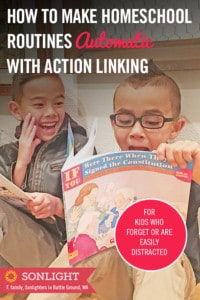 |
 |
How to Stay on Track
Ana (08:22): I tell moms all the time, “Listen, you can do everything, you just cannot do everything at the same time, so you’re going to have to figure out how to do little by little in that increment, and then keep the consistency and build a habit.” I’m going to just pull this guys, but I am a firm believe of habits, but this is what I have on my wall here. “Daily repetition creates habits, habits create structure, structure creates freedom, freedom creates time for what matters the most.” This is my motto, this is my motto. If you start applying those habits, be consistent, start incrementing little by little, and you see that daily repetition comes so natural to us nowadays.
Ana (09:03): Oh my goodness, my kids know exactly the order of what we do, which kind of looks like this. I showed you guys my ideal week schedule, but this is what I keep laminated right in front of me on my desk. If we are on the road we have our Sonlight bag that we carry with us. Guys, seriously we call it our tote-schooling, but something that we need from Sonlight is in this bag. The moment that we’re getting in the truck to travel from place to place, that bag gets out of the RV and right on my feet in the truck. We have this inside the bag to tell us exactly what we need to get done. Even though it’s the same thing almost every single stay, still we’re very visual people, they look at the laminated schedule, they go like, “Oh yeah, I need to do my history now. Oh, I need to do my science right now,” so it helps them.
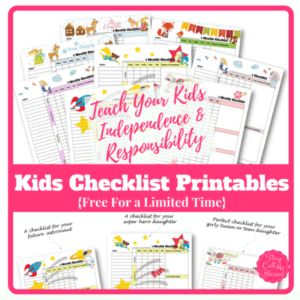 Ana (10:06): Again, if you’re going to create a routine, if you’re going to create a schedule, have it visual, have it printed out for everybody, and have it in a place where everyone can see so everybody’s coming along and following the same routine. Now I don’t even need to tell my kids what they need to get done next, because they know and they use this little cute checklist that I created for them years ago that now thousands of homeschool family uses because they don’t… It’s like our number one download on the blog and you can personalize. They write down what needs to get done for chores, what they can do individually, what we do together. Then any extras that they might be doing, like music, Hebrew, art, whatever they’re doing. Monday they get a printout and they have this little pocket that I got at the dollar store, and they know exactly what needs to get done.
Ana (10:06): Again, if you’re going to create a routine, if you’re going to create a schedule, have it visual, have it printed out for everybody, and have it in a place where everyone can see so everybody’s coming along and following the same routine. Now I don’t even need to tell my kids what they need to get done next, because they know and they use this little cute checklist that I created for them years ago that now thousands of homeschool family uses because they don’t… It’s like our number one download on the blog and you can personalize. They write down what needs to get done for chores, what they can do individually, what we do together. Then any extras that they might be doing, like music, Hebrew, art, whatever they’re doing. Monday they get a printout and they have this little pocket that I got at the dollar store, and they know exactly what needs to get done.
Ana (11:06): So you’re reaffirming your routine, your schedule, but also you’re teaching them to be independent. They’re not asking you a thousand times, “What’s next mom? What do I need to do now?”, because they know.
Stephanie (11:23): That’s great, that’s great advice. I’ll drop the link to that below, so if you need it you can access it quickly.
Ana (11:29): Yeah.
Say It With Me: “I Am Not Behind.”
Stephanie (11:33): With all that’s going on in our world, I think there are a lot of people who are maybe taking a little bit of slow time right now and adjusting to all the changes, it affects both homeschoolers and non-homeschoolers alike. You guys are socialized and out in the world, and doing all kinds of stuff, it’s not like we’re sitting at home and not going to practices and parks and the store even. How do you make sure you don’t get behind on your schoolwork during these times when you kind of need to take a break, and spend some time with the family, and reassess what’s most important in life?
Ana (12:14): Yeah, well first of all, Stephanie, I’d like to remind all parents here, either you’re starting to homeschool now or you’ve been homeschooling for a while, that when you’re home educating there’s no such a thing as being behind. You need to follow your kids’ pace of learning and you need to be flexible to the situations in your life. You know I went through a very traumatic time just about a year ago where I had to be in bed for six months, and I call it my paper plate and audio book season of life. You need to be flexible and adjust to that situation, and that’s where the beauty of teaching my kids to be independent learners came in very well. It was amazing, they carried on doing their basics.
Ana (13:05): Stick to the essentials and stick to the basics, even if it’s just language arts, math every single day, and a audio book or a read-aloud, have the kids taking turns to read the books. But don’t feel like you need to do everything when those situations come, or right now that we are quarantine that you need to get everything done if something is impeding you from doing so. I am pretty impressed that while traveling for five months through 29 states in the United States, my kids finished their curriculum before we came back to Canada. Now we are in March, almost in March, and they finished curriculum last month. Even though we were traveling, even though we were doing school in the truck many, many times, because they’re used to the consistency of the routine they got their things done.
Stick with the Basics and Read-Alouds
Ana (14:05): I want to encourage you, maybe you are in a season right now where you feel like, “I can barely get my kids to do one page,” it will get better if you do not give up. Just keep being consistent and make learning fun. Make learning fun. If there are certain things that they really enjoy doing, do more of it, I’m totally okay with that. I remember when we were starting Sonlight D, all my kids wanted to do was read Pedro’s Journal, and then we just kept reading all the books. What was the one with the lion? Oh my goodness, I forgot. I forgot, about the children that were in England and they wanted to come to the states to see their father. I can’t remember the name of the book, but my kids-
Stephanie (14:52): I just had this book the other day.
Ana (14:54): Oh my, it’s so good. It’s so good, oh my goodness.
Stephanie (14:58): Yes, yes.
Ana (14:59): That’s why I love Sonlight, because they pull these amazing books that you learn so much just reading them. Anyways, it was pretty cool because when we were back in Jamestown, in Yorktown, in Williamsburg this year, my kids were like, “Do you remember that story?” It was so cool how they associate.
Stephanie (15:20): That is so awesome.
Ana (15:22): Yeah, so just if they love reading stories, just keep reading the stories. They’re all going to be fine, guys. They’re all going to be all right.
Stephanie (15:35): Yes, absolutely. I wanted to pull up the book, I know I just had it but I can’t find it that quickly. Something else we were talking about before we pressed record was having-
Ana (15:48): The global crisis?
READ MORE ON THE SONLIGHT BLOG
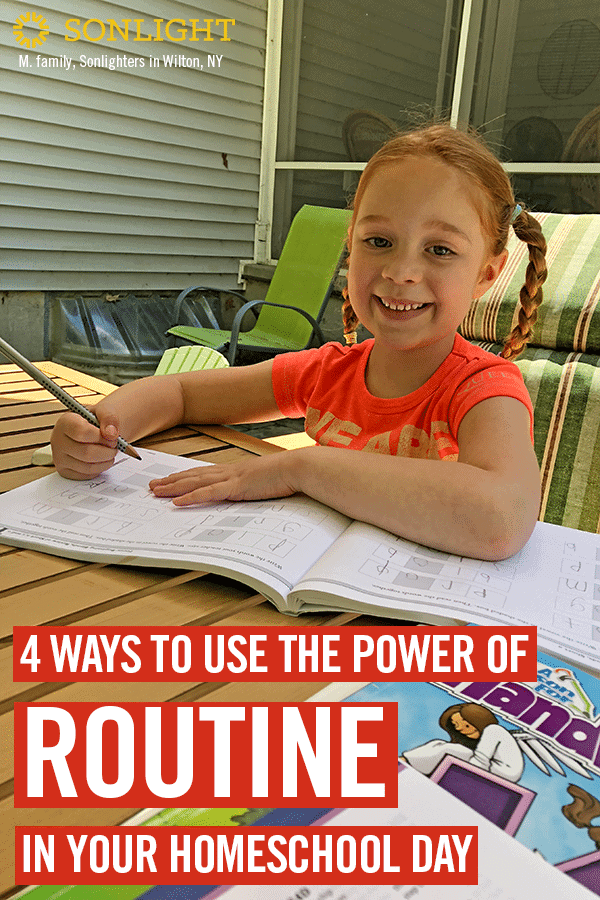 |
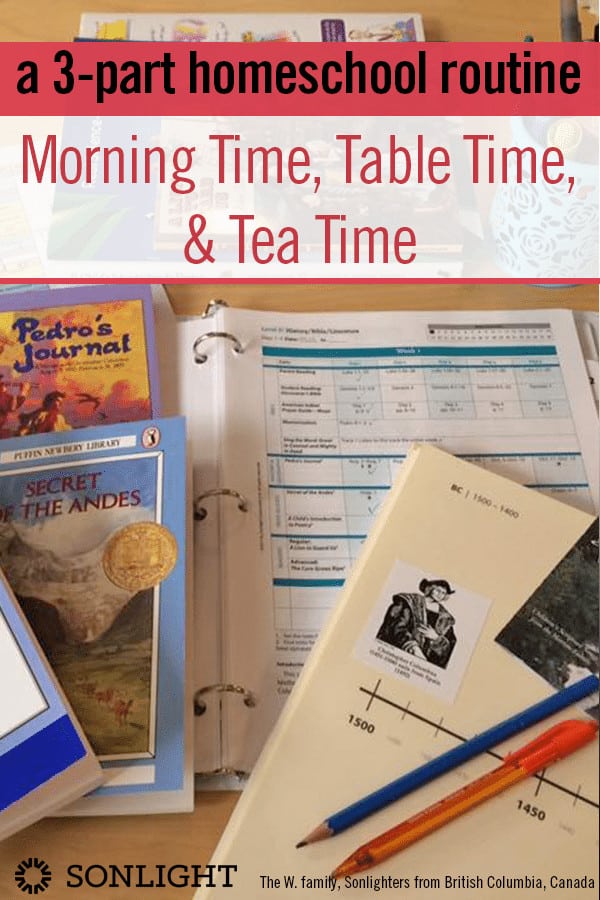 |
Homeschooling with Your Spouse Home All Day
Stephanie (15:50): Yeah, the actual problem here, having your spouse at home all the time. How do you adjust to that?
Ana (16:00): I call it on the Facebook page the global crisis that no one is talking about. So many of the mothers were like, “This is so right on,” but it is. For some of us who have been homeschooling and we are so used to being home with our children every single day, and we follow the guidelines and follow the routine, having the husband home could be really tricky because daddy doesn’t know what’s supposed to be done when.
Stephanie (16:29): You kind of have to un-school home, too. Like, “Hey this is our schedule, get used to it.”
Ana (16:36): Yeah, so I think the best thing that you can do is have a family meeting, sit down. First sit down with your spouse. Sit down with your spouse, don’t say it in front of the kids, “Now that you’re here I want to share our routine with you so you can help me and back me up, and not get the kids distracted or anything.” When my husband came home six months ago, because now we work together at home, but when he came home it was like my kids were used to doing everything with me. Now suddenly I’m like, “Okay, come sit here.” “No, I want to do it with daddy.” Now I’m wasting like five, 10 minutes because I’m telling the child, “Come on, let’s do it,” and they’re like, “No, I want to do it with daddy.” But daddy wasn’t available at that time, “So no, I’ll wait for daddy.” I’m like, that really threw me off.
Ana (17:32): But sit down with your spouse, talk about it, and share the routine. Then have a family meeting and say, “Hey guys, dad is going to be home these days.” If daddy needs to be working in a specific area of the house, just kind of, “Hey guys, daddy’s going to be working so we need to make sure that we’re not interrupting daddy.” If daddy is not working at home but he’s going to be home then, “Hey guys, daddy’s going to be helping us with our homeschool, which which is going to be super cool because we can get this done faster and then you guys can go outside for fresh air,” or whatever it is, “Or you guys can play puzzles, or you can play video games,” or whatever. We don’t play video games here, but I’m just throwing it out there because I know there’s a lot of kids who do. Just try to make it work, team work, right? Team work.
Stephanie (18:23): Yeah, team work.
Ana (18:26): Keep the husbands busy, give them something to keep them busy.
How to Handle Screen Time in Your Homeschool Schedule
Stephanie (18:30): For sure, for sure. That actually lends really good into the next question. How do you suggest managing school time, free time, screen time? How do you do that and what advice do you have?
Ana (18:50): Remember that little checklist I showed you? It’s really little, I don’t know if you guys are going to be able to read. It says here after they finish what they’re supposed to do, it says, “You are free to play for the rest of the day once you’re done with your homeschool work and chores. I’m proud of you and I love you so much, mom.” They know responsibility comes before entertainment. When they were very little we learned this poem by Christina Rossetti, and every time that it needs to be reminded we all end up saying it together, it’s “Work while you work, play while you play. [inaudible 00:19:31]. All that you do, do with your might. Things done by half are never done right.”
Ana (19:38): I taught this poem to them when they were maybe three, four, five. It’s always a good reminder. When we work, we work diligently. When it’s time to play, then just go, go ahead and go do whatever what they want. In that free time it could include the screen time. I do monitor a lot what my kids watch. Really, I monitor a lot, you guys. I’m a bit of a freak because I believe the eyes are the windows to the soul, and I believe that everything that they see and everything they watch needs to be good for them, it needs to build them up, and it needs to be in agreement with our values and our faith. We love watching things like Torchlighters and Friends and Heroes.
Ana (20:36): My kids, they have access to Minno, which used to be called JellyTelly, or RightNow Media, or Pure Flix. I know it’s good, clean, entertaining for them. That’s basically how it is here, that way they’re just not sitting where they’re going on YouTube and searching God knows what. There’s a few learning apps that they have access to, that they can play, that we know that it’s safe enough for them to play with. That’s basically how it is. We’re just teaching them, one we want them to master inactivity. There’s no such a thing as because I don’t have a screen in front of me I’m bored. We want them to be resourceful, we want them to be creative, that’s what we want them to do. I’d much rather see them playing board games than seeing them sitting in front of a video game. That’s the reality because playing board games they’re building so many skills in team work and they’re connecting with each other as siblings. That’s how I do it, that’s how I did it.
Scheduling Self-care Time
Stephanie (21:48): I love it, I love it. That’s all great advice. You lived in an RV so this question is going to be really hard, but how do you get private time as a parent for sanity and to get some work done? How do you do that?
Ana (22:05): If you don’t schedule it, you won’t get it done. When I showed you guys, maybe I should show you one more time, I’m going to share this with you guys, my ideal week schedule. Let me show this to you guys. Here’s my secret: I book absolutely nothing after dinnertime. Even though it’s my family time, I still have time enough that I have wiggle room, that’s how it is. If you see, even my self-care time, my work time, every block it’s set, it’s scheduled for it. I know the amount of time that I have to work, I have the amount of time that I have to be focusing fully on homeschooling, and I know what time I need to start dinner and whatever chores I need to get done. But I know that I have hours in the day to catch up with anything that I need to if I have to, if I absolutely have to. Otherwise, that’s sacred time for my family and I, that’s sacred time for me to rest.
Ana (23:32): I have an autoimmune disease, so life can get pretty hectic sometimes for me. Just now our online courses we have over 5,000 students, which is career. We have a homeschool membership program that has 230 families from all over the world and we have a lot of activities actually that happens twice a week for those families, including three book clubs and family workshops where we teach them all kinds of things, from Spanish to all kinds of things, all fun things. But I have to guard my time very wisely, that’s how I need to do. I need to guard it very wisely and allow myself plenty of white space on my calendar that if I need an overflow area to go to, it’s there for me. It’s there for me.
Ana (24:31): Moms, let me tell you the biggest thing I have ever learned in my life, is that not every opportunity is your assignment. Learn to say yes to what God has called you to say yes to, don’t take a commitment that you were never called to. Just be very wise, learn how to say no, it’s actually a great thing.
How You Know You’re Doing Enough
Stephanie (24:56): Yeah, for sure. That’s great advice, I need to say no more, I know this about myself. How do you know if you’re doing enough?
Ana (25:10): You know you’re doing enough by the fruits. Just like when you plant a garden, you’re not going to see things right away, it’s going to take some time. But after you’ve been planting a garden every single year, you know the fruits are going to be there every single time, it’s just going to take a little time to see it. The Bible says that “No work in the Lord is in vain,” I believe that with all my heart. It’s a natural law of life, if you sow you will harvest, you will, the seeds will grow. Whatever you’re doing, it’s producing fruits, either you see it now, or you see it a year from now, or you see it five years from now, it’s producing fruit.
Ana (26:01): I believe that doing less is actually doing more. I love that Sonlight taught me that since the beginning. Keep your lessons short. Guys, this is amazing. You have this to help you with everything that you need to get done, and no matter where you go, what you do, it’s right there. Sometimes you got one week done in two weeks, three weeks, because of the circumstances of our lives. Sometimes we’ve got two weeks done in one week. You will learn to navigate and know when it’s enough. You’re going to learn how to have more confidence in yourself as you go. Your kids will always learn, nothing’s going to be wasted.
Stephanie (26:48): That’s excellent advice, thank you so much.
Ana (26:50): Every time I test my kids, every time we tested them, they were always above the average of the public school, always. I don’t have to worry anymore. You can talk to any homeschool moms, they’re going to tell you the same thing.
Stephanie (27:08): It’s true, it’s true. The last question I have is really for those people who are finding themselves schooling at home now and the school has given them schedules, they’ve gotten them online, they’re trying to adjust that schedule, how? You talked about the rhythm, and I just want to make sure that we have really given them all the advice we can. How can we enhance or round out that schedule to really fit the family? So [crosstalk 00:27:41] very high level and then diving in.
Test the Waters Before You Dive in
Ana (27:45):Like I said, keep it simple. Keep it simple and increment little by little. If this is a completely new situation to you… I mean, okay, let’s just imagine you go to the pool, you have no idea how cold or hot the water is. You dip your toes first, and then you’re probably going to sit by the pool and you’re going to put… you know what I mean?
Stephanie (28:11): Yeah.
Ana (28:11): You’re going to put your legs there for a little while and get used to it. At least for me, it takes a little while to jump in.
Stephanie (28:18): Test the waters, yep.
Ana (28:19): It’s the same thing with homeschooling. Friends, dip your toes for a little bit, see how it goes, get used to the temperature of the water. Just be wise. Durenda Wilson is a friend of mine and she taught me this in her book. She said, “We must be students of our children.” This time that you’re home with your children, study them, observe them, know what they like, what they don’t, how they respond to things, how they process things. What peaks their curiosity? Use those things in your advantage. If there’s topics of interest that they really love, just go and explore those topics first of all before you bring the whole thing in front of them.
Ana (29:17): Let them get curious about learning, remember that you are a facilitator of learning, that because they’ve been taught in the public school by teachers they will look at you like, “You’re not my teacher,” but you’re their moms. Maybe you feel like they don’t see that learning authority in you, so that’s when you need to become a facilitator of learning. You come and learn alongside them. Say, “Guys, I don’t know this, but I’m learning with you.” Just like anything else in life, take the pressure off your shoulder right now, you don’t need to know everything to teach them, you just need to be one step ahead. Sometimes one step ahead is just have your instruction manual in front of you, and that’s enough.
Ana (30:14): That’s enough because they don’t even know how much you know unless you tell them. Learn together, just come alongside them and learn together. Make it fun, make it interesting, don’t put pressure on them, otherwise you’re going to turn them off. But at the same time, don’t drop the ball either. Keep little by little just dipping your toes, being consistent, and eventually they’re all going to come aboard and have fun, because that’s what happens. My kids cannot imagine ever not being home with us learning.
Stephanie (30:53): Well all of your advice has been so valuable. I know that homeschooling parents and those now schooling at home, everyone will find that valuable. Thank you so much for joining me today and I will drop links down below, look for everything we’ve referenced. Thanks for being here.
Ana (31:14): Thank you so much, Stephanie. I love you guys and it’s always a pleasure to be here.
Stephanie (31:19): Bye.




